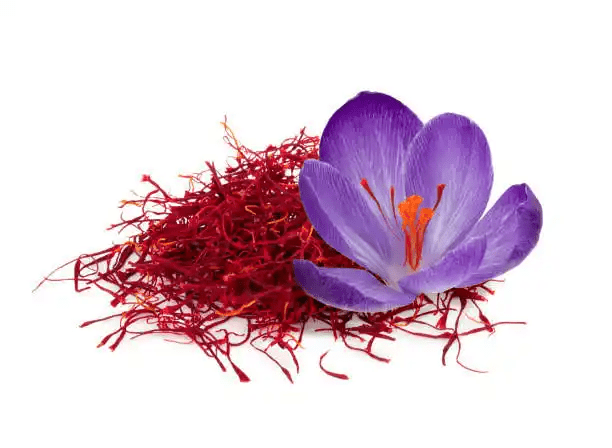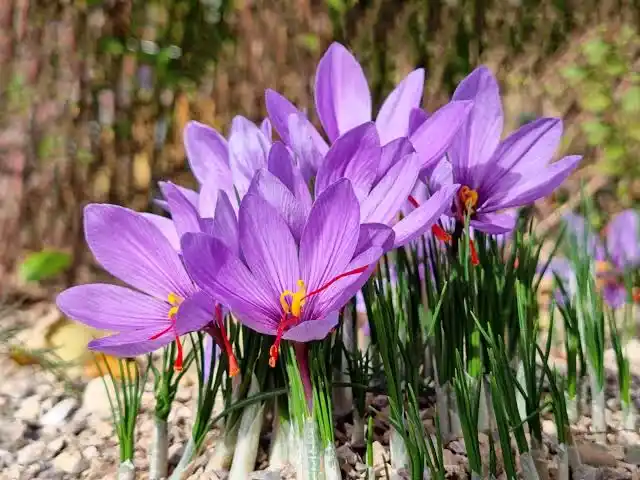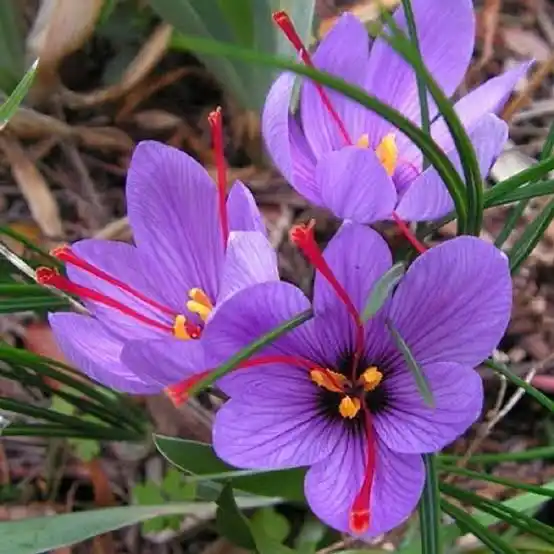Saffron, scientifically known as Crocus sativus, is a perennial flowering plant that belongs to the Iridaceae family. Renowned for its crimson-colored stigmas, which are meticulously harvested and dried to produce saffron spice, this plant has been highly prized for its culinary, medicinal, and even cultural significance for centuries.
Crocus sativus is characterized by its slender, purple-petaled flowers, each of which produces three bright red stigmas. These stigmas, commonly referred to as saffron threads or strands, are the most valuable part of the plant and are used as a spice in various culinary dishes.
Cultivation of saffron is a labor-intensive process as each flower produces only a small number of stigmas, and they must be carefully hand-picked. It takes a substantial number of flowers to yield a significant amount of saffron, contributing to its reputation as one of the most expensive spices in the world.
In culinary applications, saffron is prized for its distinct flavor, aroma, and vibrant color. It imparts a unique, slightly bitter taste and a subtle floral fragrance to dishes. Saffron is a key ingredient in various international cuisines, particularly in dishes such as paella, biryani, and risotto. Its culinary use extends beyond savory dishes to include desserts, teas, and beverages.
Beyond its culinary significance, saffron has a history of use in traditional medicine. In traditional Persian medicine, saffron was believed to have various health-promoting properties. It was used to alleviate digestive issues, enhance mood, and address respiratory conditions.
Contemporary research has explored the potential health benefits of saffron, with studies suggesting its antioxidant, anti-inflammatory, and neuroprotective properties.
Saffron has also been studied for its potential mood-enhancing effects. Some research indicates that saffron may have antidepressant properties and could be used as a complementary approach in managing mild to moderate depression.
However, it’s important to note that saffron supplementation should be approached with caution, and individuals with existing health conditions or those taking medications should consult with a healthcare professional before using saffron for medicinal purposes.
In addition to its culinary and medicinal uses, saffron has cultural significance in various traditions and rituals. It has been used in religious ceremonies, as a dye, and as a symbol of wealth and prestige.
Crocus sativus, the saffron plant, stands out for its vibrant crimson stigmas and multifaceted significance. From its role as a prized spice in culinary creations to its historical use in traditional medicine and cultural practices, saffron continues to captivate and contribute to various aspects of human life.
As with any natural substance, it’s important to appreciate and utilize saffron responsibly, understanding both its cultural heritage and potential benefits.
The Botanical Description of Saffron
1. Crocus sativus Flower: Saffron emerges from the Crocus sativus flower, a herbaceous perennial that typically reaches a height of 20-30 centimeters. The flower showcases a cup-shaped structure with three vivid crimson stigmas extending from its center.
2. Thread-like Stigmas: The most prized component of saffron is its thread-like stigmas, commonly referred to as saffron threads. These crimson filaments are meticulously hand-harvested from the center of the flower, contributing to saffron’s distinctive color and flavor.
3. Lilac-Colored Petals: Surrounding the coveted stigmas are lilac-colored petals that add to the visual appeal of the Crocus sativus flower. The contrast between the deep red stigmas and the surrounding petals is a defining characteristic.
4. Three Red Stigmas per Flower: Each Crocus sativus flower produces three red stigmas, which are the saffron threads. These threads are delicate, requiring careful handling during the harvesting process to preserve their quality.
5. Corms and Bulbs: Saffron plants grow from corms, underground storage organs similar to bulbs. These corms play a crucial role in the perennial nature of the Crocus sativus plant, allowing it to regrow and produce flowers seasonally.
6. Grass-Like Leaves: The plant features grass-like leaves that emerge from the base of the flower. These leaves are slender and green, providing a complementary backdrop to the vibrant flowers.
7. Saffron’s Bloom Period: The flowering period of saffron typically occurs in the autumn, with flowers appearing for a relatively short duration. This seasonality adds to the exclusivity and value of saffron.
The Geographic Distribution of Saffron
1. Origin in Southwest Asia: Saffron is believed to have originated in Southwest Asia, with historical evidence suggesting its cultivation in regions that now comprise Iran, Greece, and Turkey. The plant’s cultivation has ancient roots, dating back thousands of years.
2. Expansion to the Mediterranean: The cultivation of saffron expanded to the Mediterranean region, including countries like Spain, where saffron became a significant agricultural commodity. The arid climate and well-drained soils of these regions are conducive to saffron cultivation.
3. Saffron in India: India is a major producer of saffron, particularly in the region of Jammu and Kashmir. The high-altitude fields of Pampore in Kashmir are renowned for producing high-quality saffron, contributing to India’s global saffron market share.
4. European Cultivation: Saffron cultivation extended to various European countries, including Italy and France. These regions with suitable climates and soil conditions embraced saffron cultivation, adding diversity to the global saffron market.
5. Saffron in North Africa: Morocco and other North African countries also cultivate saffron, benefiting from the climate and soil characteristics that support the growth of the Crocus sativus plant.
6. Global Expansion: Over time, saffron cultivation expanded globally, with countries such as Afghanistan, Azerbaijan, and New Zealand joining the ranks of saffron producers. This global distribution ensures a year-round availability of saffron in the market.
7. Challenges in Cultivation: Despite its adaptability, saffron cultivation faces challenges related to climate change and variations in weather patterns. The delicate nature of saffron flowers makes them susceptible to changes in temperature and precipitation.
8. Modern Greenhouse Cultivation: In response to climate challenges, some regions have adopted modern greenhouse cultivation methods to control environmental variables and ensure a stable saffron production.
The Chemical Composition of Saffron
1. Crocin: Responsible for saffron’s vibrant red color, crocin is a carotenoid compound with antioxidant properties. It is water-soluble and imparts the characteristic hue to saffron threads.
2. Picrocrocin: This compound contributes to saffron’s bitter taste. When saffron threads are steeped or infused, picrocrocin undergoes a transformation into safranal, contributing to the spice’s aromatic profile.
3. Safranal: Safranal is the compound responsible for the distinct aroma of saffron. It is released when picrocrocin, the bitter compound in saffron, is broken down, especially during the steeping or drying process.
4. Crocetin: Known for its antioxidant properties, crocetin is a carotenoid compound that contributes to saffron’s color. It also possesses potential health benefits.
5. Zeaxanthin: An antioxidant carotenoid, zeaxanthin is found in saffron and is associated with eye health. It plays a role in protecting the retina from oxidative damage.
6. Lycopene: While lycopene is more commonly associated with tomatoes, saffron contains this carotenoid, contributing to its overall antioxidant profile.
7. Alpha-Carotene: Another carotenoid present in saffron, alpha-carotene, adds to the spice’s antioxidant content.
8. Beta-Carotene: Well-known for its presence in carrots, beta-carotene is also found in saffron, providing additional antioxidant benefits.
9. Vitamin B2 (Riboflavin): Saffron contains vitamin B2, contributing to its nutritional profile. Riboflavin plays a vital role in energy metabolism.
10. Vitamin B3 (Niacin): Niacin, a B-vitamin found in saffron, is essential for various bodily functions, including energy production and DNA repair.
Read Also: Jersey Cow: Grooming and Care Guide
The Medicinal Health Benefits Of Saffron (Crocus sativus)

1. Antioxidant Properties: Saffron is rich in antioxidants that help combat oxidative stress in the body, potentially reducing the risk of chronic diseases.
2. Mood Enhancement: Compounds in saffron, such as crocin, may have mood-enhancing effects and contribute to alleviating symptoms of mild depression and anxiety.
3. Improved Sleep Quality: Saffron’s calming properties may aid in promoting better sleep quality, making it beneficial for individuals with mild sleep disorders.
4. Anti-Inflammatory Effects: Saffron exhibits anti-inflammatory properties, which may help in reducing inflammation and easing symptoms associated with inflammatory conditions.
5. Cardiovascular Health: Saffron may contribute to cardiovascular health by improving blood flow, reducing cholesterol levels, and supporting overall heart function.
6. Vision Protection: The antioxidant components in saffron, including crocin, may help protect the retina and support eye health, potentially reducing the risk of age-related macular degeneration.
7. Menstrual Symptom Relief: Saffron may alleviate symptoms of premenstrual syndrome (PMS) and menstrual discomfort, providing relief to individuals experiencing menstrual symptoms.
8. Cognitive Function: Compounds in saffron may support cognitive function and memory, making it a potential ally in preventing age-related cognitive decline.
9. Anti-Cancer Properties: Some studies suggest that saffron may have anti-cancer properties, inhibiting the growth of certain cancer cells and acting as a potential adjunct to cancer treatment.
10. Respiratory Health: Saffron’s anti-inflammatory effects extend to the respiratory system, offering potential relief from symptoms of respiratory conditions such as asthma.
11. Digestive Health: Saffron may aid in digestion by promoting the production of digestive enzymes and reducing inflammation in the gastrointestinal tract.
12. Weight Management: Compounds in saffron may have appetite-suppressant effects, contributing to weight management and potentially assisting in weight loss efforts.
13. Diabetes Management: Some studies suggest that saffron may help regulate blood sugar levels, making it a potential supplement for individuals with diabetes.
14. Anti-Aging Effects: The antioxidant properties of saffron may contribute to anti-aging effects, supporting skin health and reducing the appearance of age-related skin issues.
15. Immune System Boost: Saffron’s immune-boosting properties may enhance the body’s natural defenses, helping to ward off infections and illnesses.
16. Joint Health: Saffron’s anti-inflammatory effects may extend to joint health, providing relief for individuals with conditions such as arthritis.
17. Aphrodisiac Properties: Traditionally, saffron has been associated with aphrodisiac properties, potentially enhancing libido and sexual function.
The Methods of Usage to Achieve the Provided Health Benefits Of Saffron (Crocus sativus)
1. Culinary Uses: Incorporate saffron into culinary creations such as soups, stews, rice dishes, and desserts to benefit from its antioxidant properties.
2. Saffron Tea: Brew saffron tea by infusing a few strands in hot water. This method is suitable for promoting relaxation and improving sleep quality.
3. Saffron Supplements: Consider saffron supplements, available in various forms such as capsules or extracts, for a concentrated dose of its health-promoting compounds.
4. Topical Applications: Create saffron-infused oils or creams for topical application, potentially benefiting skin health and providing anti-aging effects.
5. Saffron Milk: Prepare saffron-infused milk by steeping saffron strands in warm milk. This soothing beverage may contribute to mood enhancement and relaxation.
6. Herbal Remedies: Explore traditional herbal remedies that incorporate saffron for conditions such as respiratory issues, digestive discomfort, and menstrual symptoms.
7. Saffron Extracts: Some health benefits of saffron can be obtained through standardized saffron extracts, which ensure consistent and controlled dosages.
8. Ayurvedic Practices: Integrate saffron into Ayurvedic practices, where it is often used in combination with other herbs for holistic health benefits.
The Side Effects Of Using Saffron Medicinal Plant
1. Allergic Reactions: Individuals with allergies to plants in the Iridaceae family, which includes saffron, may experience allergic reactions. It is crucial to perform a patch test before widespread use.
2. Pregnancy Concerns: Pregnant individuals should exercise caution with saffron, as excessive consumption may lead to uterine contractions. Consultation with a healthcare professional is advisable.
3. Hypotension Risk: Saffron may lower blood pressure, and individuals with hypotension should monitor their blood pressure levels when using saffron supplements or extracts.
4. Potential Drug Interactions: Saffron may interact with certain medications, including blood-thinning drugs. Consultation with a healthcare provider is essential, especially for those on prescribed medications.
5. Stomach Upset: Excessive consumption of saffron may lead to stomach upset, nausea, or vomiting. Adhering to recommended dosage guidelines is crucial to avoid digestive discomfort.
6. Blood Sugar Regulation: Individuals with diabetes should monitor their blood sugar levels when using saffron, as it may impact glucose regulation.
7. Crocin Syndrome: Excessive consumption of saffron may lead to “crocin syndrome,” characterized by yellow discoloration of the skin. This condition is reversible upon reducing saffron intake.
8. Potential for Adulteration: Due to saffron’s high value, there is a risk of adulteration with lower-quality substances. It is essential to source saffron from reputable suppliers.
9. Impact on Pregnancy: Pregnant individuals should avoid excessive saffron consumption, as high doses may lead to complications. Moderation is key.
10. Interaction with Central Nervous System Medications: Saffron may interact with medications affecting the central nervous system, necessitating careful consideration for individuals on such medications.
11. Impact on Blood Clotting: Saffron’s potential antiplatelet effects may impact blood clotting. Individuals on anticoagulant medications should exercise caution and consult healthcare professionals.
12. Gastrointestinal Distress: In some cases, saffron consumption may lead to gastrointestinal distress, including cramps or diarrhea. Adhering to recommended dosages can help mitigate this risk.
Read Also: 17 Medicinal Health Benefits Of Yerba Santa (Eriodictyon californicum)
The Scientific Research and Studies of Saffron (Crocus sativus)

1. Antioxidant Properties: Several studies have investigated the antioxidant properties of saffron, highlighting its potential in combating oxidative stress and reducing the risk of chronic diseases.
2. Neuroprotective Effects: Research suggests that saffron may have neuroprotective effects, with compounds like crocin and safranal showing promise in mitigating neurodegenerative conditions.
3. Anti-Inflammatory Effects: The anti-inflammatory properties of saffron have been explored in studies, indicating its potential in reducing inflammation and contributing to the management of inflammatory disorders.
4. Anticancer Potential: Some studies have explored the potential anticancer properties of saffron, with findings suggesting its inhibitory effects on the growth of certain cancer cells.
5. Antidepressant Properties: Scientific investigations have delved into the antidepressant properties of saffron, with positive outcomes in alleviating symptoms of mild to moderate depression.
6. Cardiovascular Health: Research has explored saffron’s impact on cardiovascular health, including its potential to improve lipid profiles, reduce cholesterol levels, and support overall heart function.
7. Anti-Diabetic Effects: Studies suggest that saffron may have anti-diabetic effects, influencing factors such as blood sugar levels and insulin sensitivity.
8. Respiratory Health: Scientific research has investigated saffron’s potential benefits for respiratory health, particularly in conditions such as asthma and bronchitis.
9. Antimicrobial Properties: Studies have explored saffron’s antimicrobial properties, highlighting its potential in inhibiting the growth of various bacteria and fungi.
10. Reproductive Health: Research has been conducted on saffron’s impact on reproductive health, including its potential effects on male fertility and the management of conditions like polycystic ovary syndrome (PCOS).
The Safety Precautions and Recommendations In Using Saffron (Crocus sativus) Medicinal Plant
While saffron offers various health benefits, it is essential to consider safety precautions and recommendations to ensure its responsible use:
1. Moderation in Consumption: As with any medicinal plant, moderation is crucial. Excessive consumption of saffron may lead to adverse effects, and recommended dosages should be followed.
2. Allergic Reactions: Individuals with known allergies to plants in the Iridaceae family, which includes saffron, should perform a patch test before widespread use to avoid allergic reactions.
3. Pregnancy Precautions: Pregnant individuals should exercise caution, as high doses of saffron may lead to uterine contractions. Consultation with a healthcare professional is advisable.
4. Blood Pressure Monitoring: Individuals with hypotension should monitor their blood pressure levels when using saffron, as it may have hypotensive effects.
5. Drug Interactions: Saffron may interact with certain medications, including blood-thinning drugs. Consultation with a healthcare provider is essential, especially for those on prescribed medications.
6. Avoiding Adulterated Products: Due to the high value of saffron, there is a risk of adulteration. It is crucial to source saffron from reputable suppliers to ensure its purity.
7. Consideration for Children: The use of saffron in children should be approached with caution, and consulting with a pediatrician is advisable before incorporating it into their diet or healthcare regimen.
8. Monitoring Blood Sugar Levels: Individuals with diabetes should monitor their blood sugar levels when using saffron, as it may impact glucose regulation.
FAQs About Saffron (Crocus sativus) Medicinal Plant
1. Is saffron safe for pregnant women?
While moderate use is generally considered safe, pregnant individuals should consult with a healthcare professional to determine an appropriate dosage to avoid complications.
2. Can saffron be used in cooking?
Yes, saffron is a versatile spice used in various culinary dishes, providing both flavor and color.
3. What is the recommended dosage of saffron for health benefits?
The recommended dosage varies depending on the health goal. It is advisable to follow guidelines provided by healthcare professionals or supplement manufacturers.
4. Are there any age restrictions for saffron consumption?
While saffron is generally safe for adults, caution is advised for children. Consultation with a pediatrician is recommended.
5. Can saffron be used topically for skincare?
Yes, saffron-infused oils or creams can be applied topically for potential skincare benefits.
6. Are there any reported cases of saffron allergies?
Individuals with allergies to plants in the Iridaceae family, which includes saffron, may experience allergic reactions. Performing a patch test is advisable.
7. Does saffron have interactions with medications?
Saffron may interact with certain medications, especially blood-thinning drugs. It is crucial to consult with a healthcare provider if you are on prescribed medications.
8. Can saffron be used for respiratory conditions?
Research suggests that saffron may have benefits for respiratory health, potentially assisting in conditions such as asthma and bronchitis.
9. How should saffron supplements be taken?
Saffron supplements should be taken according to the recommended dosage provided by the manufacturer or healthcare professional. They are often available in capsule or extract form.
10. Does saffron have an impact on mood?
Compounds in saffron, such as crocin, may have mood-enhancing effects, contributing to its potential role in alleviating symptoms of mild depression and anxiety.
11. Can saffron be used for skincare purposes?
Yes, saffron’s antioxidant properties may contribute to skincare benefits, and it can be used topically in oils or creams.
12. Is saffron safe for individuals with diabetes?
While some studies suggest anti-diabetic effects, individuals with diabetes should monitor their blood sugar levels when using saffron and consult with healthcare professionals.
Read Also: Waste Resource Recovery Techniques

